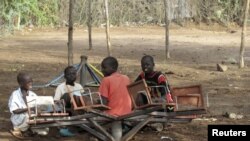KAKUMA, KENYA - Kakuma refugee camp in northern Kenya is filling up again with a new wave of refugees fleeing conflict in parts of Sudan and South Sudan. According to United Nations High Commissioner for Refugees more than 7,700 people have arrived in the camp so far this year, 75 percent of them from Sudan and South Sudan.
The U.N. refugee agency says they receive an average of 100 new refugees at Kakuma per day, mainly from South Sudan.
Refugees are citing tribal conflict, cattle rustling, indiscriminate killings and burning of houses in Jonglei state as reasons for fleeing.
Amour Dau, 31, is a mother of six from Jonglei state. She says she fled her home for fear that violence might spread.
There were some rebels, who came to our village, Dau says, and looted our belongings and burnt our houses, that’s why I came here to save my life. But I left behind my husband who is a government soldier.
Another refugee, Achol Deng, 37, lost her husband and one child in the tribal conflict between her Dinka tribe and the rival Murle. She says her happiness will depend on the sort of assistance she will receive in the camp.
I am not happy at what happened back home, she says, people were being killed, houses burnt, I had to flee and seek asylum here. If I settle well in the camp and get good care I will be happy.
Kakuma camp was first opened in 1992. It has hosted thousands of refugees who fled the civil war in Sudan, which ended in 2005. In December of that year, UNHCR began voluntary repatriations of thousands of Sudanese from the camp.
Jeff Savage, UNHCR’s senior protection officer in Kakuma, says South Sudanese prefer coming to Kakuma camp than going to other camps in Ethiopia.
“Many of them are coming to Kakuma because either they are used to being refugees here, repatriated or they heard from other relatives," said Savage. "We are wondering why they are going to Kakuma, which is much further than the camps in Ethiopia for instance.”
The 20-year camp is designed to hold up to 100,000 people. As of this month, there were 94,000 refugees and asylum-seekers from 13 countries living there.
The U.N. refugee agency says they receive an average of 100 new refugees at Kakuma per day, mainly from South Sudan.
Refugees are citing tribal conflict, cattle rustling, indiscriminate killings and burning of houses in Jonglei state as reasons for fleeing.
Amour Dau, 31, is a mother of six from Jonglei state. She says she fled her home for fear that violence might spread.
There were some rebels, who came to our village, Dau says, and looted our belongings and burnt our houses, that’s why I came here to save my life. But I left behind my husband who is a government soldier.
Another refugee, Achol Deng, 37, lost her husband and one child in the tribal conflict between her Dinka tribe and the rival Murle. She says her happiness will depend on the sort of assistance she will receive in the camp.
I am not happy at what happened back home, she says, people were being killed, houses burnt, I had to flee and seek asylum here. If I settle well in the camp and get good care I will be happy.
Kakuma camp was first opened in 1992. It has hosted thousands of refugees who fled the civil war in Sudan, which ended in 2005. In December of that year, UNHCR began voluntary repatriations of thousands of Sudanese from the camp.
Jeff Savage, UNHCR’s senior protection officer in Kakuma, says South Sudanese prefer coming to Kakuma camp than going to other camps in Ethiopia.
“Many of them are coming to Kakuma because either they are used to being refugees here, repatriated or they heard from other relatives," said Savage. "We are wondering why they are going to Kakuma, which is much further than the camps in Ethiopia for instance.”
The 20-year camp is designed to hold up to 100,000 people. As of this month, there were 94,000 refugees and asylum-seekers from 13 countries living there.










